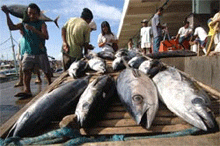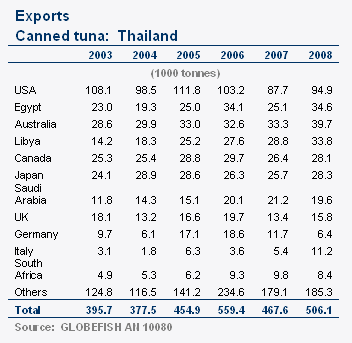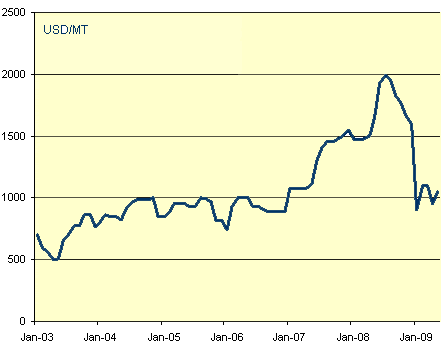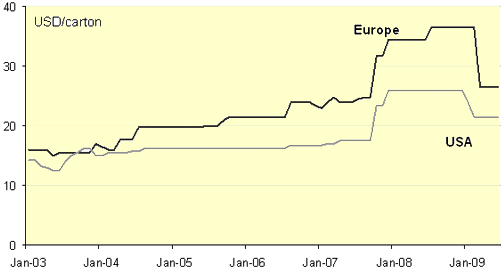Thai canned tuna exports expand further
Canned tuna is a key issue in EU-ASEAN discussions for a free trade agreement (FTA), and reduced tariff access to EU markets will come in the context of such an FTA.

However, Thailand in particular continues to be very strong in its opposition to the present EU tuna tariff regime, and Thai representatives continue to demand that EU tuna tariffs are liberalised. In addition, the Philippine industry requested that the Cotonou compromise quota be extended and the volume expanded.
Thai canned tuna exports recovered from the 2007 low. They increased by 8 per cent to 506 000 tonnes, still far off the 2006 record level of 560 000 tonnes. While 2007 had been characterised by high raw material prices, which led to lower exports, 2008 was a profitable year for the Thai industry. Canned tuna prices of exports from Thailand declined in the course of the year stimulating traders’ interest, especially in European traditional markets.

However, in the last quarter of 2008 (October – December) the export of canned tuna from Thailand experienced a negative trend as a result of the economic crisis. During this period the total export declined by 52 per cent from 225 000 tonnes in 2007 to only 108 000 tonnes last year. Except for the USA, exports to other major markets showed sharp decline during this period (October – December) such as Saudi Arabia (-70.9 per cent) Libya (-41.34 per cent), Egypt (-34.9 per cent), Japan (-7.8 per cent) and Australia (-3.5 per cent).
Despite the return of buying interest from Europe, Thailand continued with its successful diversification of markets. Exports of canned tuna to Egypt (+38 per cent) and Libya (+17 per cent) grew strongly in the course of the first nine months of 2008. The Arab world as a whole represents about 20 per cent of Thai canned tuna exports. These markets are likely to grow further in coming years.
However, the main market for Thai canned tuna continues to be the USA, with about 20 per cent of total exports. 2008 saw a good recovery of this market, after a disappointing 2007, but total exports of 95 000 tonnes are still a far way off the record level of 111 000 tonnes of 2005.
Canned tuna markets are quiet due to the current difficult and unpredictable situation in the tuna industry. After a sharp decline in skipjack raw material prices, to around USD 900 tonnes at the beginning of January 2009, it seems that the price is moving up again to USD 1 100 due to low catches. However, lower production in April, due to the holiday period, coupled with normal quantities of supply from the Western and Central Pacific allowed Thai packers to push the May price of skipjack to USD 950/tonne and lower, down USD 150 per tonne from the April price level. By the end of April, however, it was clear that increasing demand coupled with lower than expected levels of supply had already reversed the market price trend .
Thai shipjack prices

As a result of the unbalanced supply situation, most packers are taking a ‘wait and see’ attitude to let the situation settle down. Offers from packers are consequently very rare.
The overall drop in tuna raw material prices from the sky high levels one year ago, has also affected the price of canned tuna. The price of canned chunk skipjack in oil from Thailand has dropped from USD 36.50/carton last autumn to USD 25-26/carton recently on the German market. Prices of Thai canned tuna in the US market has also recently stabilized in the US market at about USD 21.50/carton.
The economic crisis has had an important impact on the canned tuna market, especially in Europe. The share of private-supermarket labels in the main markets has increased. This is mainly due to lower prices of private labels, reported sometime 20-40 per cent lower than the corresponding branded canned tuna. Therefore producers that have a strong tradition of collaboration with private labels, such as Thailand, are favoured by these developments. Overall, it is expected that canned tuna consumption will go up during this recession, as canned tuna is considered an affordable source of protein.
Thai canned tuna prices

Higher raw material prices likely
With Indian Ocean continuing catching at reduced levels, lower catch in the Western Pacific and possible demand for imports from the Western Pacific by Latin America processors and usual demands from import dependent markets, shortages of raw material are expected in June through August 2009.
Europe has demonstrated itself to be very price sensitive. Therefore 2009 should see higher imports, as canned tuna prices have dropped recently and in general canned tuna is a very competitive product compared to other sources of animal protein. However, the impact of the economic crisis still has to be fully felt by the EU member countries. Therefore importers are likely to continue for a “wait and see” tactic, in order to assess the real demand for canned tuna in European countries. At the end of the day, canned tuna prices are expected to stay at their present level for several more months to come.
June 2009

